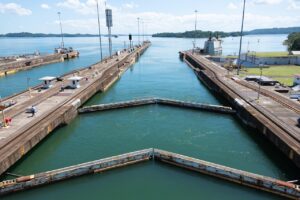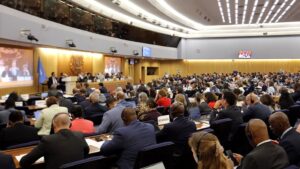Panama Canal introduces 1st GHG emissions fee on its way to carbon neutrality
On the heels of COP26, the Panama Canal has unveiled a new greenhouse gas (GHG) emissions classification system aimed at strengthening the waterway’s position as a green corridor for global trade.


Five years ago, the Panama Canal’s contributions to the reduction of emissions from the international shipping industry were presented during the International Maritime Organization’s (IMO) 70th Marine Environment Protection Committee session (MEPC 70).
Fast forward to this month, the waterway’s efforts have expanded tenfold to respond to the urgency of climate change.
The Panama Canal Administrator Ricaurte Vásquez Morales announced that the canal would take its efforts another step further, in recognition of the urgency of climate change and the need for accelerated industry and global climate action.
While speaking at AAPA Latino in Cartagena, Colombia, on November 30, Administrator Vásquez announced the Panama Canal Green Vessel Classification system, which will include a Greenhouse Gas (GHG) Emissions Fee.
As explained, these changes will build upon the waterway’s existing incentives for sustainable shipping lines, provided through its Green Connection Environmental Recognition Program. This program has evolved from the Green Connection Award, the Environmental Premium Ranking, and the Emissions Calculator.
Related Article
-
Panama Canal cut 13 million tons of CO2 in 2020
Business & Finance
Specifically, the fee will support investments to guarantee environmental performance standards and aid in making the Panama Canal operations carbon neutral.
Ships will be classified in levels depending on their energy efficiency. The classification and fee will apply to all vessels over 125 feet (38.1 meters) length overall (LOA). This classification system will incorporate the following three factors that will reduce GHG emissions between 20-100 percent during transit through the canal:
- Energy Efficient Design Index (EEDI)
- Efficient operational measures such as the use of bow thrusters
- Use of zero carbon biofuels or carbon neutral fuels
The canal said it has held discussions with shipowners directly for transparency, as it evaluates these changes, and will work in partnership with customers to accelerate carbon neutrality. This program will align with the IMO’s regulations that promote international plans for decarbonization in the maritime sector.
Related Article
Carbon neutrality and digital transformation
Meanwhile, Deputy Administrator Ilya Espino de Marotta participated at the TOC Connect Conference on November 3, where she shared updates on the canal’s ongoing process to reach carbon neutrality, including upcoming plans to consolidate Panama Canal facilities to reduce its carbon footprint by 33 percent.
De Marotta also shared that, as ships transition to cleaner fuels, the canal is investing in hybrid tugboats, starting with 10 with potential to include more, which reduces 20 percent of tugboat operational carbon emissions.
In addition to hybrid tugboats, the canal will introduce a fleet of electric vehicles as well. Maintaining and modernizing the canal’s infrastructure is also a priority for securing a sustainable future.
For the remainder of the decade, the Panama Canal plans to invest several billion dollars in equipment, infrastructure, technology, and the water solution project, among others. This plan will also include a step towards digitizing canal operations to provide more value for customers. With more data, the canal says it can better anticipate customer needs and tailor its operations to sustainable solutions.
Advocating for shipping decarbonization at COP26
At the start of the month, the Panama Canal joined world leaders at COP26 in Glasgow to advance global climate action.
On November 4, the Panama Canal participated at the UNFCC’s Action Hub, with a TED-style presentation to international delegations and industry leaders on how sustainable maritime routes can drive climate action.
The canal stressed the importance of having the entire supply chain, from shipping lines to final customers, involved in the sustainable transition.
“We need to understand that being part of the maritime business can and should support the global effort of reducing carbon emissions,” Alexis Rodriguez, Environmental Specialist, said during the presentation at the UNFCC’s Action Hub.
“Shipping will continue to play a big role in the supply chain, as COVID-19 continues to impact imports. We need to have clear guidelines across all international bodies to reach these goals.”
From there, the Panama Canal was also present at the International Chamber of Shipping (ICS) side event “Shaping the Future of Shipping” on November 6, showcasing the advantages of the Panama Canal’s green route and the value green corridors provide to international maritime trade.
Finally, Rodriguez served as a panelist for an IMO event on November 10 that explored opportunities for developing countries to provide zero-carbon fuels to global shipping. He then closed the month’s activities by joining the IMO’s MEPC meetings, where discussions around research and development for shipping decarbonization continued.
Securing the future of water availability
In 2019, the Panama Canal announced plans to invest in a series of solutions to secure water quality and quantity to support the canal and local population’s needs for at least the next 50 years.
As the latest step towards this goal, the U.S. Army Corps of Engineers (USACE) will provide technical assistance for the project to ensure operational sustainability, engineering services and overall analysis of the project.
USACE will work together with canal professionals to develop the conceptual design for water alternatives. Both organizations have a longstanding partnership, dating back to the canal’s construction in 1914.








